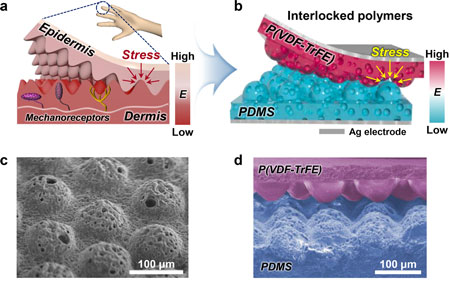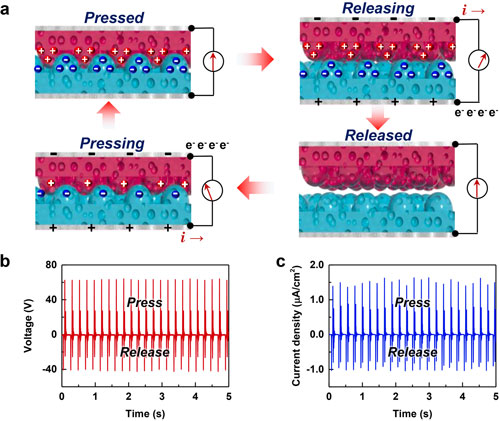| Posted: May 22, 2018 | |
Nature-inspired nanotechnology: skin-mimicking sensors |
|
| (Nanowerk Spotlight) Human skin is composed of various layers. The stiff outer layer (epidermis) contains no blood vessels and protects the lower, vascular layers (dermis), which nourish it. Stiff and soft layers are interlocked with micro ridge structures. | |
| "Thanks to the gradient stiffness of skin layers and geometry of interlocked micro ridges, human skin can effectively concentrate and transfer the external stress to the underlying mechanoreceptors and thus sensitively detect the mechanical stimuli," Hyunhyub Ko, an Associate Professor in the School of Energy and Chemical Engineering at Ulsan National Institute of Science and Technology (UNIST) in South Korea, explains to Nanowerk. "Mimicking the exciting skin structure and function, we designed hierarchical nanoporous and interlocked micro ridge structured polymers with gradient stiffness." | |
| The gradient elastic modulus of interlocked and micro ridge structured polymers effectively transfers the external stress and induces the large frictional contact between two polymeric layers, which facilitates their use in self-powered triboelectric sensors. | |
| Furthermore, the additional nanoporous structures in the micro ridge structured polymers lead to the effective variation of both volume and gap distance between opposing surfaces without the need of bulky spacers, resulting in ultrathin and flexible triboelectric sensors for applications in wearable electronics. | |
| Ko and his team have reported their findings in ACS Nano ("Skin-Inspired Hierarchical Polymer Architectures with Gradient Stiffness for Spacer-Free, Ultrathin, and Highly Sensitive Triboelectric Sensors"). | |
 |
|
| Skin-inspired and hierarchical polymer architectures for spacer-free, ultrathin, and highly sensitive triboelectric sensors (TESs). (a) Structural and functional characteristics of human skin. The different elastic modulus (E) of epidermis-dermis layers with interlocked micro ridges effectively transfer the external stress to underlying mechanoreceptors. (b) Hierarchical and interlocked micro ridge structured P(VDF-TrFE) and PDMS-based TESs. Scanning electron microscopy (SEM) images of (c) nanoporous and micro ridge structured PDMS and (d) interlocked with hierarchically structured P(VDF-TrFE). (Reprinted with permission by American Chemical Society) (click on image to enlarge) | |
| Most of the conventional triboelectric sensors require bulk spacers, rigid accessories, and volumetric designs to obtain enough gap distance between the two contacting surfaces that are proportional to the triboelectric output performance. However, due to the bulky spacers, traditional triboelectric sensors are not thin enough to be conformably worn on the body. | |
| "Even without additional spacers between the two contacting surfaces, micro ridge structures on our polymeric layers can act as spacers to provide an effective variation of gap distance between opposing surfaces," notes Ko. "Furthermore, additional nanoporous structures in the micro ridge structured polymers lead to the effective variation of both volume and gap distance between opposing surfaces, resulting in high-performance triboelectric sensors. This allows the fabrication of spacer-free, ultrathin, and flexible triboelectric sensors." | |
| The team fabricated spacer-free, ultrathin, and flexible triboelectric sensors that can easily be worn on the body and sensitively perceive vital signs, voice, and a variety of bodily motions. | |
| They demonstrated the device's sensing capabilities to detect pressure/bending stress, cardiovascular signals, high frequency of acoustic vibrations, human voice, and a variety of hand motions. One interesting demonstration was a smart glove to recognize sign language. | |
 |
|
| Working principle of self-powered TESs and triboelectric output performances. (a) Schematic illustration of triboelectric charge generation and current flow mechanism between hierarchical and interlocked micro ridge structured P(VDF-TrFE) and PDMS. Triboelectric output (b) voltage and (c) current density under vertical pressure of 19.6 kPa with 4 Hz. (Reprinted with permission by American Chemical Society) | |
| These sensing capabilities of this novel triboelectric sensor can potentially be used in diverse applications such as health-monitoring devices, wearable fitness trackers, biometric security system, prosthetic limbs, and robotics. | |
| In its current design, the team's flexible triboelectric sensor still lacks stretchability due to the stiff silver film and nanowire electrodes. However, they are already working on stretchable electrode technology in order to fabricate skin-conformal and stretchable triboelectric sensors. | |
 By
Michael
Berger
– Michael is author of three books by the Royal Society of Chemistry:
Nano-Society: Pushing the Boundaries of Technology,
Nanotechnology: The Future is Tiny, and
Nanoengineering: The Skills and Tools Making Technology Invisible
Copyright ©
Nanowerk LLC
By
Michael
Berger
– Michael is author of three books by the Royal Society of Chemistry:
Nano-Society: Pushing the Boundaries of Technology,
Nanotechnology: The Future is Tiny, and
Nanoengineering: The Skills and Tools Making Technology Invisible
Copyright ©
Nanowerk LLC
|
|
|
Become a Spotlight guest author! Join our large and growing group of guest contributors. Have you just published a scientific paper or have other exciting developments to share with the nanotechnology community? Here is how to publish on nanowerk.com. |
|
